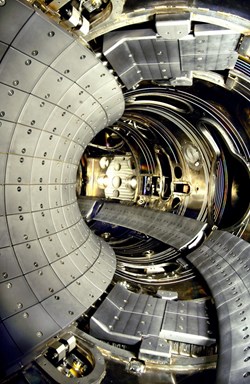
The burn chamber of the TEXTOR tokamak at Forschungszentrum Jülich, where each year in January Japanese and German fusion scientists have a ''Japanese Week'' of joint material experiments for fusion reactors. Copyright (2): FZJ
Material erosion under fusion-relevant conditions is of critical importance for all materials applied to ITER. A recent campaign at the German-based tokamak
TEXTOR, jointly conducted by the Research Centre in Jülich and the Japanese University of Tohoku upon the initiative of the International Energy Agency (IEA), studied the erosion and melt behaviour of tungsten on a longer timescale.
Founded in response to the 1973/74 oil crisis the International Energy Agency (IEA), with its headquarters in Paris, is an autonomous organization which works to ensure reliable, affordable and clean energy for its 28 member countries and beyond. Today, one of the main focus areas is energy security, i.e., promoting diversity, efficiency and flexibility within all energy sectors and most of all ensuring the stable and economical supply of energy for the future.
One of IEA's Technology Initiatives—also known as Implementing Agreements—is the Program of Research and Development on Plasma-Wall Interaction in TEXTOR which has existed since 1978 with its member countries USA, Japan, Canada and the European Union. TEXTOR—a medium sized tokamak operated by Forschungszentrum Jülich (FZJ) in Germany—was constructed in 1982 to develop novel technologies for the extraction of energy from the burn chamber of nuclear fusion reactors. Due to its configuration TEXTOR is predestined to run so-called "high risk" experiments that could not be conducted easily in other fusion machines.
While in the past experiments at TEXTOR under the IEA Technology Initiative focused on thin-film coating technologies for large burn chambers (e.g., boronization and carbonization) as well as helium pumping and the optimization of graphite tiles, current test campaigns focus on the testing of tungsten structures in the boundary plasma of the TEXTOR machine.
As a best-choice material for the divertor, tungsten is of crucial importance for the success of ITER and that of later power plants (also see Newsline
#206 and
#207). To determine the material's limits or operational regime, fusion scientists from Japanese universities and research institutes met in Jülich from 23-28 January to perform joint experiments with their colleagues from Forschungszentrum Jülich, using TEXTOR as the test bed and the IEA Implementing Agreement as the organizational frame.

Taken to the limits: a tungsten bulk sample after exposure to the edge plasma in Jülich's TEXTOR tokamak. Even the chemical element with by far the highest melting point of 3422 °C can melt—good to know for ITER's envisaged all-tungsten divertor.
During this campaign highly refined tungsten samples were exposed to the hot TEXTOR plasma in order to study two crucial questions related to material lifetime and performance: material erosion under fusion-relevant conditions and crack resilience under intensive transient and steady state heat loads.
The University of Tohoku had developed toughened, fine-grained and recrystallized (TFGR) tungsten materials for the experimental campaign that contained trace amounts of the chemical compounds TiC (Titanium Carbide) and TaC (Tantalum Carbide) in the percent range. Having been exposed to Jülich's electron beam test facility JUDITH before performing the actual experiment inside the burn chamber of TEXTOR, the materials showed impressive performance to transient heat loads.
The tests—together with the initial surface analysis of the samples—revealed a release of the contained titanium at a temperature of 1500 °C. In addition, microstructural changes in the melted surfaces were observed which could degrade performance under ITER-like plasma loads to a major extent. Further analysis of the test samples will now be performed in Japan and also at Jülich with the aim to characterize the change of the material's microstructure and its chemical composition in more detail.
"The all-tungsten divertor in ITER will be facing several challenges with respect to material lifetime and durability due to erosion and potential melting," said Jan Willem Coenen, leading scientist at FZJ and EFDA Fellow, who coordinated the campaign together with his colleagues from Jülich. "Studying advanced materials as well as existing material choices allows for a broader understanding of the material properties required for ITER and beyond."
To enhance international collaboration even further and to address material problems in nuclear fusion research in a more pronounced way, the intention is to widen the scope of the present IEA Technology Initiative. TEXTOR will continue to serve as a reliable workhorse for some time, but more and more use will be made of especially dedicated material test facilities like the linear plasma experiment JULE_PSI which will become operational by 2015 at Jülich,
MAGNUM-PSI operated by DIFFER in the Netherlands,
PISCES run by UCLA at San Diego and
NAGDIS at the University of Nagoya in Japan. The new collaboration will also be open to non-member countries of IEA like China.



